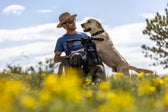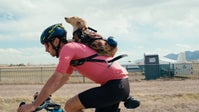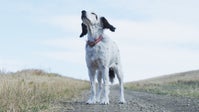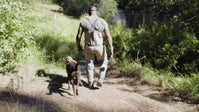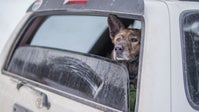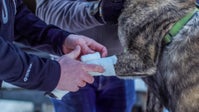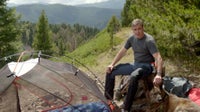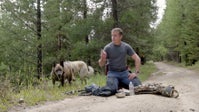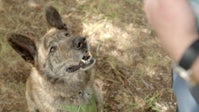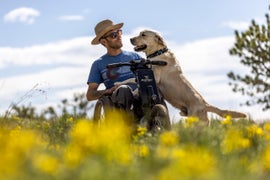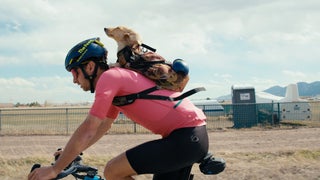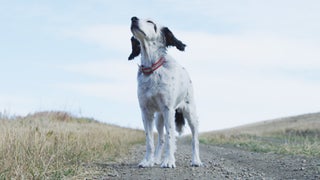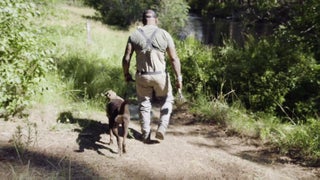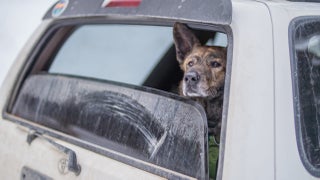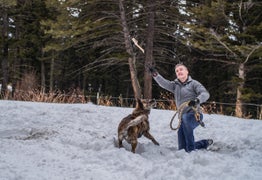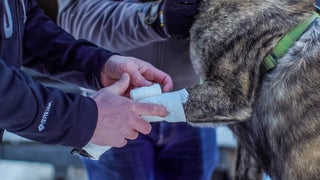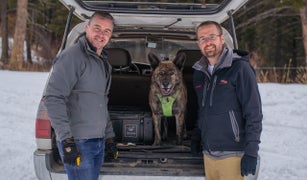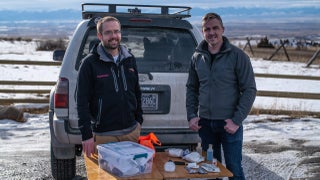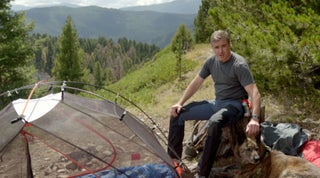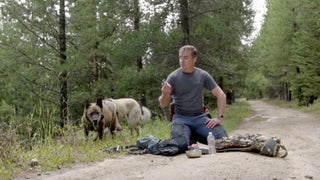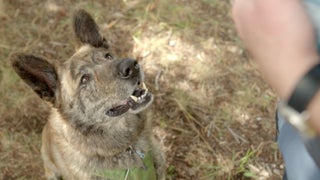WES SILER: So what you see here is Joe's suggestion for a first aid kit. And this is something you'd carry in your truck, right? This is not something you would take on the trail.
JOE SPOO: So it's both. So I kind of have the two set ups. So I have the one that you're going to carry in the truck to address major things. And then I have a smaller version of it that I actually carry in my pack.
WES SILER: Because I was looking at this table, and I'm going, man, my base weight is going just, like, so--
[MUSIC]
[HOWLING]
JOE SPOO: What I have here is kind of my basic, at the truck major kit that you're going to be able to handle all of the things that you should. And then a smaller kit that, you know, if you're a couple hours away from your vehicle and you're going to need to address some things, that smaller kit that you can throw in your pack so that you're ready for those things that occur out in the field as well.
WES SILER: And that's more like it gets you back to the truck--
JOE SPOO: Exactly.
WES SILER: --where you can do a little more. And then from there, go to the vet.
JOE SPOO: Exactly. So if there's an emergency that you need to temporarily stabilize until you get back is what the smaller kit is for.
WES SILER: Gotcha.
JOE SPOO: Yep. And so the basics of it, we'll kind of go through each of these items. So digital thermometer, which every dog loves because we take the temperature rectally. And where you're going to use that is two situations. And so here, in the winter, you get a dog that we worry about hypothermia-- it gets wet and cold.
WES SILER: OK.
JOE SPOO: The other place, and the more common use, is actually the other end of the spectrum. It's in hyperthermia, or heat stroke. And unfortunately, we see a lot of that-- people running their dogs when it's too hot. And so the big thing with the temperature is normal is 100 to 102.5.
And so it's not that your dog is hyperthermic or in heat stroke if it's above 102.5. There isn't a magic temperature. So you can have a very active dog, and that dog might be up around 105.
The big thing with heat stroke is, does the temperature fall? So if we take that temperature back at the truck, and it's 105 or 106, and we wait five minutes, and we take that temperature again and it's still 105 or 106 or maybe 107, we know that's a dog that's in trouble. And so that's where the thermometer is going to come in.
And then we talk about some of the simple things. So I use a lot of saline for rinsing wounds. And so I carry it in a couple of different forms. The big thing-- back 10 years ago, the contact aisle was all saline with capsules and tablets. Now it's all mixed solutions and you really have to hunt for just the straight saline.
WES SILER: Yep.
JOE SPOO: So I use this for my wound flush. And then you can have a separate eyewash or you can use this as an eyewash. And so I use a couple of bottles of these every year. I go through a lot of the saline.
And then, carrying a simple sugar solution-- so some dogs will get hypoglycemic, or low blood sugar. And so I actually carry dextrose. This isn't technically an IV solution, but you can give it in the mouth.
And so if you get a dog that is an overexcited dog that taps out its blood sugar, this can be, in an emergency situation, to get that blood sugar back up, we can use the dextrose situation.
WES SILER: OK.
JOE SPOO: I do carry hydrogen peroxide. And a lot of us think of that as a wound flush. And I actually hate hydrogen peroxide as a wound flush, so--
WES SILER: Because it's painful.
JOE SPOO: And it causes tissue damage.
WES SILER: Yes.
JOE SPOO: And so when-- that bubbling, when your mom used to clean out your cuts, and the bubbling we thought was a healing action, at the microscopic level, it's actually causing tissue damage. And so why I have hydrogen peroxide in the kit is that if your dog eats something that it shouldn't, this is how we can induce vomiting. So if you happen to run across coyote bait or something out in the woods and you need to get that back up, you're going to use hydrogen peroxide to do that.
I'll carry some surgical scrub to be able to clean out wounds. And then various bandaging material. And I carry just a clean, white t-shirt, which might seem like an odd thing to carry in a first aid kit. But if you think about it, if you get a massive injury-- so that dog jumps over a fence and fillets open its entire chest, or happens to open up its abdomen, you can pack off a big area. And because it's white, you're going to see that blood start coming through if you don't have enough pressure.
And then we have various bandaging things. So kind of a cling wrap-- and this is like a disposable ACE bandage. Some tape, some wrap to hold on some of the bandages-- so some cotton wrap. Gauze sponges, to be able to cover wounds. I'll use these to scrub things out.
Some cotton wrap-- and so if we have a broken leg, or a very heavily injured leg, we're going to wrap that a little bit thicker. So we'll use a cotton wrap, the cling wrap, and then the over wrap with that.
Some nonstick pads will be important, as well. So if you get a road rash-type of injury, we can kind of cover those up.
As far as drugs and things like that, I'm pretty simple, as far as what I carry in the kit. So triple antibiotic for those types of wounds. And I don't like to treat infections with it. So I look at this as kind of a temporary bandage. And so if a dog gets a big cut, I'll clean it out, flush it out with the saline, put the triple antibiotic on there and cover it up. But then, when I get back to town, either that wound is going to need to be closed up or we're going to go to oral antibiotics if it's a nasty, kind of stinky infection.
And then I like to carry triple antibiotic for the eye. And so the big thing is they're different. And so you get that dog that happened to scratch its eye or had a bunch of weed seeds in the eye, I like to carry triple antibiotic for the eye. And so this would be something you'll need to get from your veterinarian.
And then if your dog's on any prescriptions-- the big thing, you know, if you're out hiking, you're out in the field, and let's say your dog has thyroid medication or seizure medication, I would always carry a couple of days' supply with you in the kit. So that way, if you're back in the back country and you forgot the bottles at home, you always have them in the vehicle should you run out or you get stranded.
As far as tools go, I'm pretty simple on that front, too. And so I'll carry a needle nose pliers. And so this would be the dog that gets into it with a porcupine and you need to pull a couple of quills.
WES SILER: Yeah.
JOE SPOO: The other thing, too, will be sometimes they'll embed sticks or things into their paws. And so it allows you to pull that.
WES SILER: Can you just use a multi-tool there?
JOE SPOO: You can.
WES SILER: Yeah. OK.
JOE SPOO: You absolutely can.
And then, as far as other instruments, hemostats-- again, basically for the same purpose. The big thing is, again, just for smaller things. So a dog gets something down in its ear or up its nose, this is going to fit better than the needle nose. But it's the same sort of thing-- pulling stuff out of the dog.
And then tweezers-- same type of thing. And so simple tools on the tool front.
And then as far as closing wounds go, we have two options. And so I carry surgical glue. The big thing I'd say with the glue is that it's going to be for very small injuries. So a dog slits its foot pad, where it's not a deep injury, or same sort of thing with a little nick on the skin, I'd default to the surgical glue.
If a dog cuts itself open-- so you're out in the back country, and it jumps a fence or gets a big wound-- as long as it's not deep through muscle or into the body cavities, I actually like to use surgical staplers. And so most veterinarians will sell these to you and go over with you.
And so my with my clients, I don't sell them surgical stapler removers, because I'd like to see their closing job. So I have some clients that are great with closing wounds, and some clients that I've had to take the staplers away. And so having that discussion of knowing what you can close.
And then I just throw in a couple of gloves. They don't have to be sterile gloves. Again, just as you're kind of dealing with some of this stuff, it's nice to sometimes have a set of gloves to deal with.
And then cotton-tip swabs-- so basically, Q-tips. I like the wooden ones. So if we're getting things out of the eyes, out of the ears, I just feel you have a little bit more leverage with these longer, wooden-tip ones.
WES SILER: Yep.
JOE SPOO: So that's the kit that's at the truck. And so it fits in a nice little container that you can slide under the seat. Hopefully you never actually use it.
And then we have the kit that we carry on our person. And so basically, same sort of thing. Some various bandage materials, a bottle of wound flush, a bottle of eyewash.
I carry a wire cutter. And so this time of year and in the fall, we'll have where dogs can encounter snares, and so being able to get a dog out of a snare situation, I always carry several wire cutters. And I've actually upgraded into some of my kits I have cable cutters, because some of those snares you're not able to cut with just a simple wire cutter.
WES SILER: Yeah, some are really strong.
JOE SPOO: Yeah. And then I carry a smaller surgical stapler. And then again, a hemostat and a scissors for the bandage material. And that's the small stuff, right? The dog gets a major cut, I can cover it up.
WES SILER: Yeah, you can stop the bleeding, get back to the truck, do a little more.
JOE SPOO: Exactly.
WES SILER: Yeah, that's dog first aid, at least in terms of what you carry. That's going to be it for this video. We're going to cut back in for another video and show you how to use this material to actually address some of the most common injuries you're going to face. So stay tuned for that next week.
